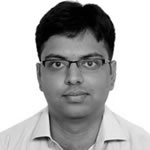Cognitive Automation (CA) , also known as Intelligent Automation, is a set of AI based technologies including Machine Learning and Natural Language Processing. The core difference between CA and generic RPA is that CA works at a semantic level and tries to understand the underlying data rather than just treating it at a superficial level.
Cognitive Automation : Advent of Virtual Workforce
Rohit Agarwal
In my last post, we discussed about the impact Robotic Process Automation is having on the Outsourcing industry. While RPA solutions are great in automating rule based tasks like report generation, macros and business workflows, they generally fail where even the slightest of human discretion is required. Tasks which need human decision making like understanding text, detecting frauds and raising alerts can not be automated with traditional RPA solutions. Due to such limitations, end to end automation becomes difficult as human intervention becomes the bottleneck. That is becoming a thing of past with Cognitive Automation.
Technology
Cognitive Automation (CA) , also known as Intelligent Automation, is a set of AI based technologies including Machine Learning and Natural Language Processing. The core difference between CA and generic RPA is that CA works at a semantic level and tries to understand the underlying data rather than just treating it at a superficial level. Also, machine learning models enables it to continuously learn from human work and evolve over time.
Cognitive Automation makes it possible to train and deploy a virtual employee with the experience equivalent of a MILLION human workers at a fraction of the cost!
Impact
Cognitive Automation coupled with existing RPA solutions is taking the enterprise world by storm. Many tech giants have introduced their own cognitive platforms to solve problems like fraud detection, news analysis, image recognition and email spam filtering. There is a migration trend from offshore services model to cloud hosted AI platforms.
IBM’s super intelligent attorney ROSS can be your perfect digital legal assistant. It can answer your queries, provide all relevant references and monitor law that can affect your case. IPsoft’s Amelia is another solution using NLP which automates customer support.
According to HFS Research, 30% of the low skilled jobs will be impacted by 2021, including data entry, invoicing and L1 customer support that amounts to around 1.5 million jobs.
The market for enterprise AI applications is projected to increase from $202.5 million (£140m) in 2015 to $11.1 billion (£7.5bn) by 2024, expanding at a compound annual growth rate (CAGR) of 56.1 per cent.
Industry analysts believe that the scope for CA is so huge that by 2020, smart machines will become a top five investment priority for almost a third of CIOs. It is the powerful capability of artificial intelligence to transform business practices that venture capitalists invested $2.38 billion in 2015.
Why integrate Cognitive Automation?
Research has shown that companies that exhibit superior performance over the long term have two distinct features.
- They tend to differentiate themselves based on value rather than price.
- They seek to grow revenue before cutting costs.
By investing in CA, companies aim to achieve both these goals. They can employ virtual workforce to automate routine tasks and assign smarter jobs to their employees. Companies see it as a way to reinvent themselves to more effectively compete in the future and consider it as a basis for business model transformation.
And, why wouldn’t anyone want to adopt CA solutions, given their benefits!
CA solutions are highly accurate, faster, easily scalable and cost-efficient . Such characteristics make CA an ideal choice when workforce needs to be employed to perform more meaningful jobs.
Get Started!
At Ikarus, we have a cognitive process automation framework which works on unstructured data like forms, invoices and emails to extract relevant information.
Write to us at info@ikarustechnology.com to explore how you can start integrating cognitive abilities into your business today!
Rohit Agarwal
Software Engineer, Entrepreneur, Working on Robotic Process Automation
The content & opinions in this article are the author’s and do not necessarily represent the views of RoboticsTomorrow
Comments (0)
This post does not have any comments. Be the first to leave a comment below.
Featured Product


